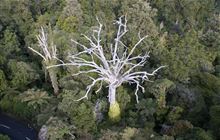Further measures to protect kauri
Archived content: This media release was accurate on the date of publication.
Introduction
Three measures that will strengthen efforts to save kauri trees from dieback disease were agreed by the Kauri Dieback Governance Group when they met yesterday.Date: 26 January 2018 Source: Ministry for Primary Industries
It was agreed to put in place:
- a Controlled Area Notice for kauri dieback
- a National Pest Management Plan
- a Strategic Science Advisory Group.
"These new measures will give greater protection to kauri. They are targeted at getting people to do the right thing and will strengthen efforts to manage the spread of kauri dieback," says Roger Smith, the Ministry for Primary Industries' chief operations officer, who chairs the governance group.
The first measure the programme's partner agencies agreed on is putting in place a Controlled Area Notice (CAN) for kauri dieback under the Biosecurity Act 1993.
"The CAN cannot ban people from going into a particular area but it would put a legal requirement on them to follow the right hygiene standards when entering or leaving areas that have kauri. We aim to make these safeguards as easy as possible to follow," says Mr Smith.
Mr Smith says the aim is to have the CAN in place over the coming months and that it will be rolled out in stages.
"A staged approach will enable us to target higher priority areas first and not reach beyond our capacity to deliver the work effectively. It also provides opportunities to learn and refine the controls as they are rolled-out to other places," says Mr Smith.
Work on preparing the CAN is now underway and programme partners are deciding the details of how it will be implemented. This will include deciding the first location where the CAN will initially apply.
The second measure programme partners agreed was that the CAN should ultimately be replaced by a National Pest Management Plan (NPMP) for kauri dieback.
"A national plan is used for tackling major biosecurity threats and is the strongest form of regulation we can put in place. It will provide consistent regulations for dealing with kauri dieback that apply nationally, more robust programme governance and better access to funding," says Mr Smith.
"The national plan would be a longer-term measure for managing kauri dieback and extensive consultation will be required to develop it."
The third measure agreed was to set up a Strategic Science Advisory Group to ensure the fight against kauri dieback is supported by the necessary science and research.
"This group will ensure the programme has on-going access to some of the best minds and knowledge relating to kauri," says Mr Smith.
"Kauri dieback is a destructive disease and we take our responsibilities towards managing it very seriously."
Mr Smith said it remains vital for anyone visiting forests with kauri to take personal responsibility and follow good biosecurity hygiene practices, stay on official tracks that are open and keep well clear of kauri roots. If possible, people should make use of forests and parks where kauri are not present.
"I would like to acknowledge the work partner agencies and community groups are doing to upgrade tracks, install cleaning stations and put up signage to help protect kauri."
Background information
The Kauri Dieback Programme was launched in 2009. It provides a multi-agency government and community response to managing the spread of kauri dieback. The governance group comprises representatives from Waikato Regional Council, Northland Regional Council, Bay of Plenty Regional Council, Auckland Council, Ministry for Primary Industries (MPI), Department of Conservation (DOC), and Te Roroa and Tangata Whenua.
Kauri dieback is found in the upper North Island and can kill kauri of all ages. It is a disease caused by a microscopic fungus-like organism called Phytophthora agathidicida. It lives in the soil and infects kauri roots, damaging the tissues that carry nutrients and water within the tree, effectively starving it to death. Soil disturbance from human activity like people using unofficial tracks or not cleaning footwear is one of the main ways spores can be spread.

